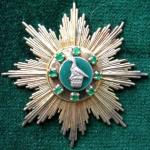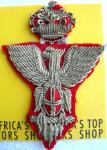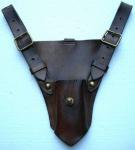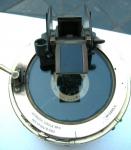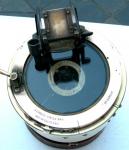-
Posts
13,225 -
Joined
-
Last visited
-
Days Won
22
Content Type
Profiles
Forums
Blogs
Gallery
Events
Store
Everything posted by Mervyn Mitton
-
It is now 29 years since the end of the Rhodesian U.D.I. period of Independence. During the short period they existed a whole network of Military ranks and Awards were created. I am showing here the miniatures of the main awards - not easy to have this reference material I hope it will of help to the collectors. The above Breast Badge was the highest award and real emeralds were used. For good ref. material on the period I recommend the books by Colonel Dudley Wall.
-
Everybody was so sure that it was to do with ships navigation, that we overlooked the -now- obvious AM initials. I think the only way to have proper I.D. will be to forward pictures to an RAF Museum. There used to be one near Hendon Police College in North London - probably closed now. Can anyone help with an address or, email ?
-

Zulu items
Mervyn Mitton replied to helen's topic in Great Britain: Militaria: Badges, Uniforms & Equipment
Peter - very good point and I'm glad to have correct info.. 1879 period - yes- they did use hobnails from the boots - and they were the pyramid shaped ones you describe , and with wear on them. I think from that , we had assumed all of these studs were from boots. Thankyou - and it's good that at least two people are reading ! Helen - the attached carving of a Zulu man shows the Isikoko being worn. This is by a famous local artist and was carved in the last 40 years - however, it shows the importance of the 'ring'. -
A WW2 South African mentioned in Despatches Group - with the citation - which is different wording to the UK. I think S.A. qualified as a war zone because of the shipping and coastline - certainly most of our groups seem to have one, at least, I have always assumed this was the case. Basic groups for S.A. are of 4, 5 or 6 medals. Four is usally North Africa - five if they went to Italy as well and six with the Defence. Don't forget we have the Africa Medal, whhich was rarely awarded to non Sth. Africans. Later in the War re-inforcements were sent direct to Italy and then it is 4 medals. Our troops were attached to the US under gen. Mark Clark and we reached as far as Florence. Field Marshall Smuts then re-called our troops due to unrest in S.A.. With this group he has his Efficiency.
-

Zulu items
Mervyn Mitton replied to helen's topic in Great Britain: Militaria: Badges, Uniforms & Equipment
Helen - item 2. Not horn - almost certianly bone. If Ivory it will feel 'cold'. Item 3 and the Isikoko's. The bottom one - cut straight from the scalp is the correct one. However, I think that we have stumbled on something very important and which I was not aware of - I will contact the Museum at Ulundi and it will be interesting if any of the anthropological experts in UK have opinions. Quite simply, my observation is that these others are 'wigs' ! Many African peoples have a tendency to lose their hair as they get older - but, an Isikoko is a mark of status and it would be almost unthinkable for a senior chief to appear without one. Therefore, I think they had copies made , which could be worn in public. People living at the time may have been aware of this, but, I have never seen reference and I think it has been forgotten. Mervyn -

Zulu items
Mervyn Mitton replied to helen's topic in Great Britain: Militaria: Badges, Uniforms & Equipment
Dear Helen - I must say thankyou for your time and trouble . I kept asking because I thought you would have some rare pieces in the collection - and boy ! was I right. Many people will look at these and see tribal artifacts, but the Zulus have to be looked at as Africa's largest tribe (12.5 million) and also, culturally, as one of the most succesful. Granted - they did not have the written word - or, the wheel in the 1820's when they were first exposed to Europeans - but what they did have were a stable monarchy, the best weaponry and a sound family system. When I have posted some Zulu items, members have shown interest and now, thanks to Helen, we have a selection of historical pieces which even many Zulus,will not be aware of and will never have seen. I feel qualified to write a short description of each item - however, please don't think of it as definitive - they are my observations and other members must comment how they see them. Helen can put us right - although, I am sorry to say, I don't think much of the label descriptions. I feel that some background on numbers may be helpful. Shaka inherited the throne from his Father in 1816 and at that time there were approx. two and a half thousand 'Zulus' - it was the family clan name and Shaka made other clans that he conquered take the generic name. When we fought the Anglo-Zulu War in 1879, the general concensus, is that there were between two hundred and three hundred thousand Zulus and the Impis - or, army, numbered some 80,000 men. When I lived in Sth. Africa in the mid-1950's the Zulus numbered three and a half million - the last census showed twelve and a half million. I will go by Helen's post numbers - each of which have two or, three items : 1 Brass anklet - this could also be an upper arm band - one has to measure. The date is prior to 1879 - we destroyed all the brass castings. 2 Ivory - or, bone, comb. From the dull look prob. bone. Hand carved they were greatly prized. 2 MAAS spoon. This is like a curdled yoghourt and very popular and nutritious. As used to be with Welsh bridegrooms these were often carved by the young man as a gift to his bride. The conical top represents a penis. One for an un-married girl will often have the shaft as two pieces. 3 .577 Martini bullets. These have been fired and were probably picked-up from one of the battle sites. Conical one has been filed down and the round ones are musket balls fired from old 'trade' muskets - sold to the Zulus by European dealers. (Think of Native-Americans in the 1860's.) 3 Penis sheath - made from grasses and worn to give some cover to the genitals and to prevent erections. Over this they wore a small hanging cover - often genet (mongoose) tails - called an iNendla. The back cover - from goat skin - is called an iBeshu. 4 Small dance shield- this is old, but they still use them in some ceremonies. 4 This is an old item - could easily be earlier than 1850's. A stool , and only the head of the Kraal was allowed to sit. 4 This is not for jiggers ( a particularly nasty insect, that lays eggs under the skin and which then happily 'munch' their way around your body. It is in fact a concealed dagger and they were often carried for protection - they even had a type of sword stick. This is not to say that it wouldn't be useful to take out thorns and larvae. The person who collected it probably saw it being used for this. 5 Zulu Axe. There are three types of Axes - those made by the Sotho people , those by the Swazis - usually triangular shaped and the homemade Zulu ones - shaped like a hoe blade or, crescent. 5 Four legged headrest - used from the early 1900's by the women to keep a new hairstyle off the ground. The decoration has either been burnt in or, they have carved the design and colured the raised bits. 5 Another dance shield. Too small to fight with - except in demonstrations. 6 Naive carving of a woman carrying a water jar. They make better weapons then they do sculptures. The best carvers are from Malawi. 6 Strip of brass rolled around a core of grass to make a neck band - men or, women. 7 Poor example of an IKLWA or, short style stabbing spear - reputed to have been invented by Shaka - in my opinion a copy of a Roman gladius. This has had the leather binding renewed and I don't think it is Zulu - it lacks the tong marks that are always present - unless covered by the binding. Also lacks the swollen handle end, which is necessary to pull the spear from a body. 7 Powder horn. Yes -the Zulus did use cow's horns for carrying the gunpowder for the 'trade' muskets. However, with the handle, I think this has been turned into a beer horn for passing around - that, or , water. What is interesting, is that the studs are from British soldiers boots and taken from the bodies after Isandlawana and other battles. They often turn up as decoration. 7 Aluminium necklace - made from an old saucepan. 8 This is a very rare item. When they saw how effective the long Martini bayonet was on the rifle - they made some of their axes with an elongated top part in order to stab as well as slash. Not many were made. This one has a lovely handle. 8 Dick King's powder horn - used on the ride to Grahamstown. I think I would want more proof than a label. Dick King and his Zulu helper rode 700 miles from Durban to Grahamstown - the nearest British settlement - I think it was in 1838(?). Our first settlement was being besieged by the Boers - who didn't like us then - or, later... He came back on H.M.S. Southampton with the 45th. Regt. and the siege was raised. Their is a large bronze of him on horseback in Durban and he is one of our local heroes. 8 Typical necklet for man or, woman. Could be hand carved verdite - a semi-precious green stone. 9 UMUTSHU worn by married Zulu ladies around the waist. Shows their married status and stops men annoying them. 11 As in 3. Penis cover. Postcard shows it being worn - the actual grass cover is in the bag. Millions are sold to tourists. 12 The rarest item you have shown - and I have never seen one. Only the King could declare when an Impi had reached 'maturity' - it could be as old as 40. He would then take on the responsibility of providing wives for the - up to - 1000 men. To show that they reached this seniority the men would allow their hair to grow. When long enough they would have the centre of ther head shaved and the fringe was then rolled-up inwards to the centre of the head. Heavily greased it eventually set as hard as wood - and remained with them for the rest of their life. The name for this is the ISIKOKO and it marked them as men. I am ashamed to say, that in the Zulu War many Govt. officials put a bounty (think of Native Americans and scalp bounties) on the bringing-in of Isikoko's and many warriors were killed and tortured to get this trophy. So, this is a man's hair - made into his mark of maturity. I hope that the descriptions have not been too long - but, at the end of the day we are dealing with the artefacts of a highly respected - and formidable - tribe. -
Brian - lovely badge. I hadn't realised that they were one of the Forces that wore shako's and this must make it quite rare. I think your point about a continuing thread is a good one - Leigh seems to do it very succesfully. Still, we've had the pleasure of seeing them and you are still making your showcase.
-
Are these the oldest items on GMIC ? Stone age implements - arrow heads - found in the South of England. They date between 5,000 and 10,000 years old. Most of them are from the Pitt-Rivers collection of the Dorchester Museum - sold off in the 1960's as surplus ? I bought three carrier bags of different pieces. The one - 2nd. from left - I picked-up in the New Forest - near Brockenhurst. Probably earlier then the more conventionally shaped ones. Our stone age ancestors were very prolific with their flint tools and you can still find good items when walking in the right places. Having a supply of flint was important to these people - by striking it in the right way - known as flint napping - they could shape and sharpen hand tools and then bind onto shafts for arrows or, spears. Fresh flint is so sharp you can shave with it - they also, made axes , knives , skin scrapers etc.. You don't see these old pieces so much now-a-days and value has gone-up. I expect this would be worth ?300 ($450). Flint gradually gave way - some 5000 years ago to bronze and then to iron. I'm waiting to see if Leigh can add one of his great postcards to this ??? The colours are quite good on this - but will add another one to show a little closer on the detail
-
The question is - should this be under British or, Italian ? During WW2 South African Forces drove through Africa - all 28,000 of them and forced 250,000 Italian troops to surrender in Abyssinia - now Ethiopia. Lt. Col.MacMillan was the C.O. of Natal Mounted Rifles - S.A.'s oldest regiment - in those early days and this Italian General's cap badge was found with his own badges. I have made enquiries but, we have never been able to find ref. to an incident where a General would have surrendered to him. Did Italian general's wear a generic badge - as ours do - or, is this for a specific rank at that time. All input greatly appreciated.
-
An interesting piece of 'kit' which is often overlooked by collectors. This is the Boer War (1899-1902) pattern frog for an officers sword in the field service scabbard. The main difference when compared with later ones, is the 'apron' between the slings.
-

HELP WITH BRIT. ARMY (?) KNIFE
Mervyn Mitton replied to Mervyn Mitton's topic in Swords & Edged Weapons
You should intro. yourself on the Lounge - not many will see it here. Once again - thanks. -
Thankyou John and Peter. I feel we have made some advance with the Air Ministry - I was convinced it was Naval, which is why I put it on this sub-forum. A friend - who I think belongs to Forum, but doesn't post - has pointed out that the bars on the compass show military use - he thinks 1930's for them - and cleverly, has pointed out that they have been stripped of their original paint, to show the brass which is more attractive in a collection. If they are from the RAF - then how and why, did they use them. I can't imagine it being on a plane - was it at the aerodrome - to guide planes in ? Another thought - could it be anything to do with anti-aircraft guns - or, observers posts?
-
Peter - please, why are you apologising ? Neither meant anything in our comments. I was very tired and when I re-read it realised that it sounded a 'challenge' - which I hadn't intended. Anyway - back to our Sirdar. I was thinking about it this morning - at this time Egypt was part of the Ottoman Empire and they, certainly used to carry emblems of authority - usually horsehair. A Pasha always had horsetails on standards carried in front of him on staffs. So, perhaps a Sirdar did also ? This rank, although having a military equivalent, was also used by civilian administrators. I think we will have to wait and see if anyone else can add - I wonder if we have any Egyptians in GMIC ?
-

The Royal Marines
Mervyn Mitton replied to leigh kitchen's topic in Great Britain: Militaria: Badges, Uniforms & Equipment
The swagger stick, I mentioned. 26.5 inches long (67cm). Will be interested if it was NCO's or, officers ? -
Wouldn't it be more effective to throw the camel at the enemy ?? Nasty, vicious brutes and apart from Man, I believe they are the only other animal to carry syphilis !!!



